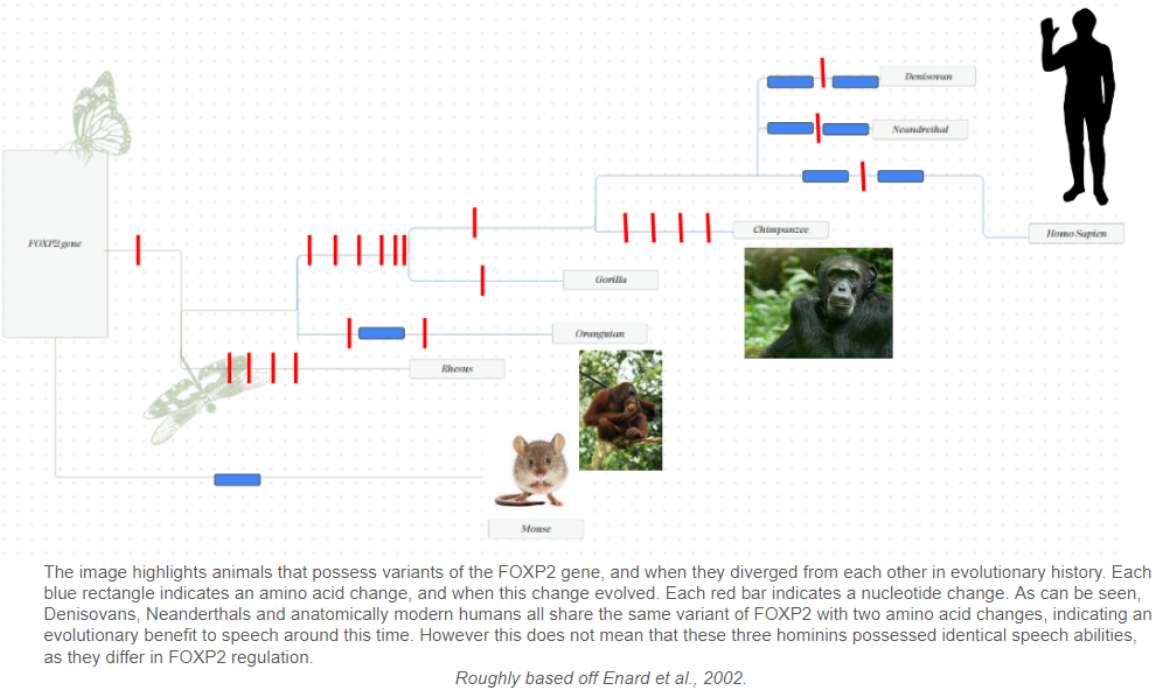Is language uniquely human? In the late 1900s, famous primates such as the chimpanzee, Washoe, and the gorilla, Koko, became sensations for their adoption of sign language, raising questions about whether primates possess language abilities similar to humans. Yet despite having some success, nearly all these experiments concluded that primates’ language abilities differ from us in an essential way: they lack the innate ability of language acquisition (Erdős, 2019). This intriguing ability is what allows infants to quickly acquire the language of their parents without being deliberately taught. Now researchers studying the genetics behind speech disorders have highlighted one gene, called FOXP2, that may be behind this innate ability, allowing us to investigate when language evolved and whether our ancestral relatives like Neanderthals and Denisovans possessed language as well.
The significance of the FOXP2 gene first emerged from studying FOXP2-Related Speech and Language Disorder, which affects one's ability to produce sounds, syllables, and words. Interestingly, this condition stems from brain abnormalities rather than issues with the throat and mouth. Because of this, people with this language disorder also have difficulty understanding speech and may have trouble writing, reading, or using proper grammar (U.S. National Library of Medicine, 2016). So far, the FOXP2 gene has been associated with language lateralization, a process that causes language to dominantly arise in the left hemisphere of the brain and may be critical for normal language development (Martin et al., 2022). The FOXP2 gene has also been linked to neurite outgrowth, which affects the plasticity and flexibility of neural connections in the developing brain, an essential aspect of language learning (Vernes et al., 2011).
Identifying the FOXP2 gene has large implications for understanding the evolutionary history of language. Scientists have already begun to compare the genomes of other species to humans to understand when our particular variant of the FOXP2 gene arose. Unsurprisingly, the variant of the FOXP2 gene that humans have today does not occur in our primate relatives. In fact, one study published in Nature found that the common ancestor of anatomically modern humans and primates had one amino acid change in the FOXP2 protein that separated it from the mouse, but that anatomically modern humans have two amino acid changes that separate us from other primates (Enard et al., 2002). This rapid transition indicates that this protein evolved recently on the evolutionary time scale, perhaps even coinciding with the first anatomically modern humans 200,000 years ago, leading to their survival and success (Enard et al., 2002).
But what about our hominin relatives? Did Neanderthals and Denisovans, now extinct human species, have language abilities as well? Scientists have recently begun to answer this question, as they can now sequence genomes from Neanderthal and Denisovan remains. Although it seems humans, Denisovans, and Neanderthals all had the same variant of the FOXP2 gene, some researchers argue that the gene differed slightly in its expression, due to the presence of a binding site for the transcription factor POU3F2 in Neanderthals which increases FOXP2 expression (Benítez-Burraco et al., 2022). In modern patients, increased expression of FOXP2 can arise due to other causes, such as possessing a duplicate of the FOXP2 gene. In these cases, increased expression delays language development, indicating that Neanderthals may have evolved advanced communication, but not quite as advanced language as Homo sapiens (Benítez-Burraco et al., 2022).
Evolutionarily, the innate ability of infants to pick up language has profound implications for the survival of groups, allowing for enhanced communication and the passing down of knowledge through generations. As we invent our own deep language models and come closer to decoding internal speech with technologies such as Neurolink, it is important to understand how language arises in our own brains. Studying the FOXP2 gene provides a key lens into the inner workings of language, allowing us to explore when and why language may have first occurred.
References:
Antonio Benítez-Burraco, Raúl Torres-Ruiz, Pere Gelabert, Carles Lalueza-Fox, Sandra
Rodríguez-Perales, & Paloma García-Bellido. (2022). Human-specific changes in two functional enhancers of FOXP2. Cellular and Molecular Biology, 68(11), 16–19. https://doi.org/10.14715/cmb/2022.68.11.3
Enard, W., Przeworski, M., Fisher, S. E., Lai, C. S., Wiebe, V., Kitano, T., Monaco, A. P., & Pääbo, S.
(2002). Molecular evolution of FOXP2, a gene involved in speech and language. Nature, 418(6900), 869–872. https://doi.org/10.1038/nature01025
Erdős, L. (2019). Talking apes – ambassadors of the animal kingdom in the human world. Green Heroes,
61–65. https://doi.org/10.1007/978-3-030-31806-2_13
Martin, K. C., Ketchabaw, W. T., & Turkeltaub, P. E. (2022). Plasticity of the language system in children
and adults. Handbook of Clinical Neurology, 397–414. https://doi.org/10.1016/b978-0-12-819410-2.00021-7
U.S. National Library of Medicine. (2016, September 1). FOXP2 gene: Medlineplus genetics.
MedlinePlus. https://medlineplus.gov/genetics/gene/foxp2/#resources
Vernes, S. C., Oliver, P. L., Spiteri, E., Lockstone, H. E., Puliyadi, R., Taylor, J. M., Ho, J., Mombereau,
C., Brewer, A., Lowy, E., Nicod, J., Groszer, M., Baban, D., Sahgal, N., Cazier, J.-B., Ragoussis, J., Davies, K. E., Geschwind, D. H., & Fisher, S. E. (2011). FOXP2 regulates gene networks implicated in neurite outgrowth in the developing brain. PLoS Genetics, 7(7). https://doi.org/10.1371/journal.pgen.1002145
